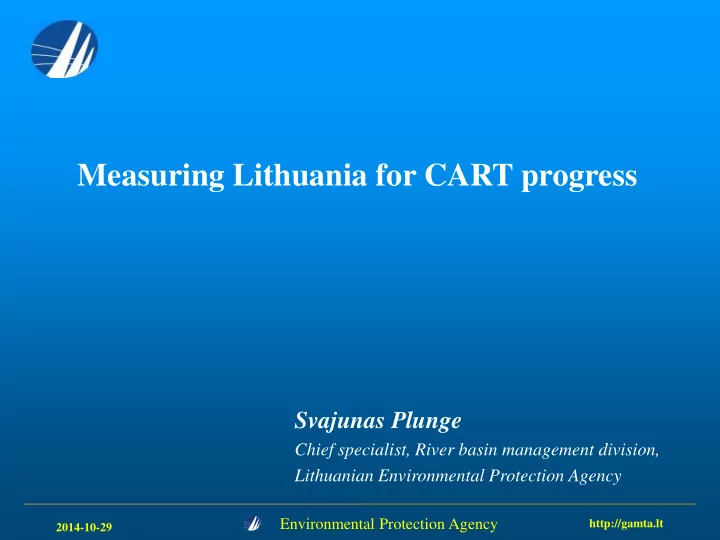

Measuring Lithuania for CART progress Svajunas Plunge Chief specialist, River basin management division, Lithuanian Environmental Protection Agency Environmental Protection Agency http://gamta.lt 2014-10-29
Relevance to the meeting • Show practice example of one country. • Raise some questions in regard to MAI/CART follow up. • Get guidance from the meeting. Environmental Protection Agency http://gamta.lt 2014-10-29
CART values CART • BAP N 8,935 (Atmo 507 Water 8,428) P 1,441 • GUR N 0 P 26 Reference loads • BAP N 44,920 P 2,635 • GUR N 5,245 P 192 Values from summary report of MAI-CART Environmental Protection Agency http://gamta.lt 2014-10-29
Calculation steps 1 1. Yearly loads t/a and flow m3/a calculated for each monitoring station. BAP LTR13 Nemunas aukščiau Rusnės, aukščiau Leitės ; BAP LTR266 Minija ties Suvernais; BAP LTR20 Šyša žemiau Šilutės; BAP LTR138 Šventoji žiotyse; BAP LTR77 Akmena- Danė žiotyse; BAP LTR1 Nemunas aukščiau Druskininkų; BAP LTR43 Neris ties Buivydžiais ; BAP LTR79 Bartuva žemiau Skuodo; BAP LTR82 Venta žemiau Mažeikių; GUR LTR86 Mūša žemiau Saločių; GUR LTR357 Nemunėlis ties Tabokine; BAP Unmonitored areas (770 km2) = LTR266 X coef. 0,2578. Environmental Protection Agency http://gamta.lt 2014-10-29
Calculation steps 2 - 5 2. Gaps filled by using relationships between adjacent basins. 3. Loads of LRT13, LTR266 and LRT20 are added to get Nemunas load and flow. 4. Loads for each monitoring post are normalized. 5. EMEP deposition data for BAP and GUR for LT. Gaps are filled with averages. Environmental Protection Agency http://gamta.lt 2014-10-29
Calculation steps 6 - 8 6. Belarus loads through Nemunas and Neris are added and multiplied with 0.46 for Ntot and 0.47 for Ptot (retention 0.54 and 0.53). 7. LT loads to BAP through LV calculated adding LTR79 (Bartuva) and LTR82 (Venta). Then multiplied with 1.288 (to compensate for unmonitored near border) and 0.61 for Ntot and 0.42 Ptot (retention 0.39 and 0.58). 8. Matrosovka channel load is calculated dividing Matrosovka flow from Nemunas flow and multiplying coefficient with Nemunas load. Environmental Protection Agency http://gamta.lt 2014-10-29
Calculation steps 9 9. Final LT load to BAP obtained: a. From Nemunas subtracting Belarus part; b. Adding loads from LTR77, LTR138 and unmonitored area; c. Adding Matrosovka channel load; d. Adding LT N deposition to BAP; e. Adding LT load to BAP through LV rivers. Environmental Protection Agency http://gamta.lt 2014-10-29
Calculation steps 10 10.Final LT load to GUR obtained: a. LRT86 (Musa) and LTR357 (Nemunelis) added and multiplied with 1.5 to compensate to unmonitored areas near border; b. LT load to GUR multiplied with 0.73 for Ntot and 0.68 for Ptot to account for retention (0.27 and 0.32); c. LT deposition to GUR is added. Environmental Protection Agency http://gamta.lt 2014-10-29
Calculation step 11 11.National ceiling calculation for BAP: a. CART for BAP is subtracted from LT reference loads to BAP; b. Subtracting Belarus load for reference period???. 12. National ceiling calculation for GUR: a. LT Ntot ceiling to GUR is equal to loads of reference period; b. For Ptot CART for GUR is subtracted from LT reference loads to BAP. Environmental Protection Agency http://gamta.lt 2014-10-29
Questions to experts 1. Should Belarus load should be subtracted from reference period loads? 2. Reference period load is right after ministerial meeting (LT to BAP through Latvia is not added, etc)? 3. What part of Matrosovka should be allocated to RU? What is retention of LT loads on it? 4. Normalization for each river or grouped? 5. How to adjust for rivers on the border? 6. How to correct earlier data (loads, reference loads)? 7. Normalization from 1994? Environmental Protection Agency http://gamta.lt 2014-10-29
Important to take into account 1. The most relevant national ceilings (not CART or MAI). 2. Reference period should be only loads from country. 3. Countries will change retention coefficients. How to avoid problems? Environmental Protection Agency http://gamta.lt 2014-10-29
N total 90000 Ntot LT 80000 National ceilings for N 70000 Ceilings for N Belarus exc 60000 Ntot t/a 50000 40000 30000 20000 10000 0 1994 1996 1998 2000 2002 2004 2006 2008 2010 2012 Environmental Protection Agency http://gamta.lt 2014-10-29
P total 3500 Ptot LT National ceilings for P 3000 Ceilings for P Belarus exc 2500 Ptot t/a 2000 1500 1000 500 0 1994 1996 1998 2000 2002 2004 2006 2008 2010 2012 Environmental Protection Agency http://gamta.lt 2014-10-29
N & P for GUR 16000 Ntot National ceilings for N 14000 12000 Ntot t/a 10000 8000 6000 4000 2000 0 1994 1996 1998 2000 2002 2004 2006 2008 2010 2012 1000 Ptot National ceilings for P 800 Ptot t/a 600 400 200 0 1994 1996 1998 2000 2002 2004 2006 2008 2010 2012 Environmental Protection Agency http://gamta.lt 2014-10-29
What it means for N? 10.0 9.0 N conc 8.0 N needed 7.0 N conc "good" 6.0 N mg/l 5.0 4.0 3.0 2.0 1.0 0.0 Environmental Protection Agency http://gamta.lt 2014-10-29
What it means for P? 0.35 P conc 0.30 P conc "good" P needed 0.25 P background 0.20 P mg/l 0.15 0.10 0.05 0.00 Environmental Protection Agency http://gamta.lt 2014-10-29
Recommend
More recommend